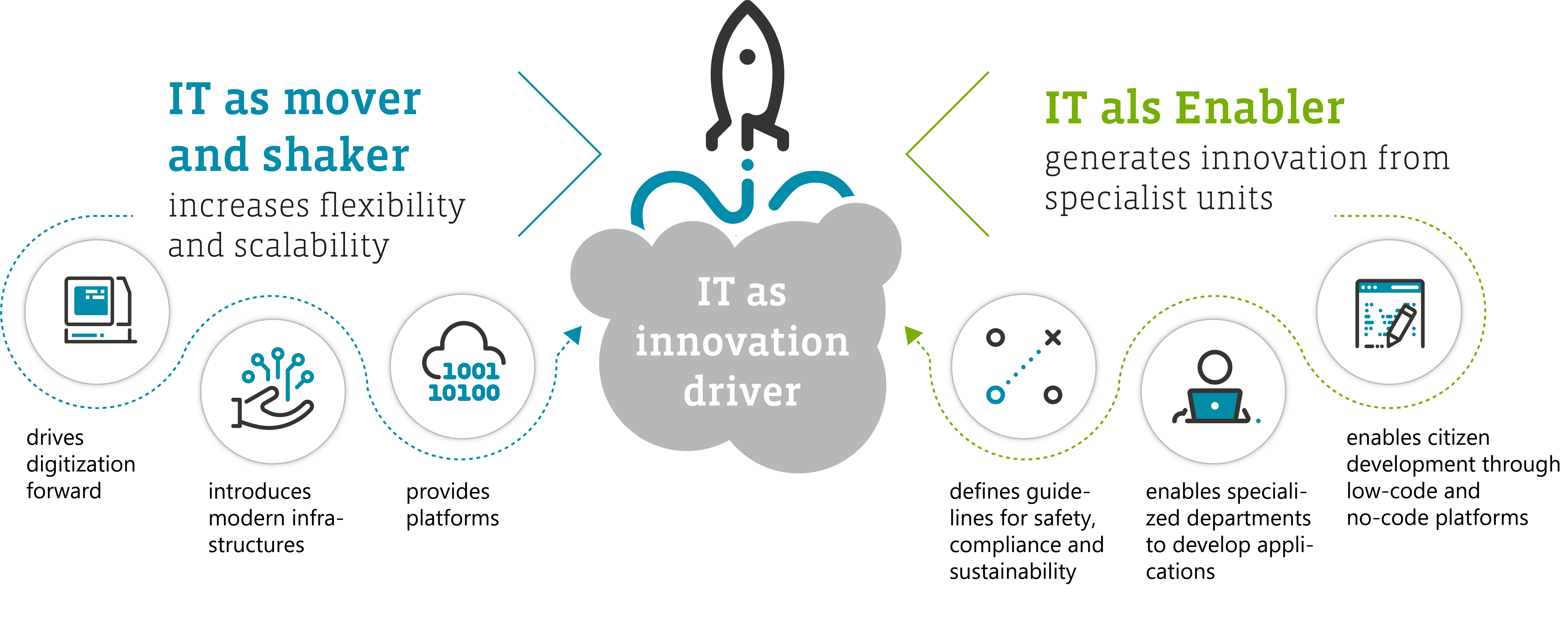Delivery bottlenecks, highly dynamic markets, shortages of skilled workers: companies have to be able to operate with sufficient flexibility and innovation to maintain and grow their edge. Digitalization plays a key role in making innovation possible – in products, services, and business processes. This requires change in the self-image of the IT sector so it can make the transition from service provider to mover, shaker, and enabler for the business.
For a long time, the only responsibility an IT team had was keeping systems running. That’s no longer enough! In today’s increasingly dynamic economic environment, companies face new challenges – and the business is constantly coming up with new requirements as well. As a result, flexibility and innovation are needed, including when it comes to infrastructures and applications. At the same time, security and compliance must be ensured reliably.
This can no longer be achieved through conventional processes. Instead, it requires consistent digitalization and transformation. That’s where a company’s IT organization comes in. It plays a starring role as drivers of digitalization when it comes to keeping the company not just efficient, but also nimble and innovative. To do that, the organization needs to actively step up and move away from its supporting role in the business. After all, with its expertise, the IT organization can tap into potential that the business side of things doesn’t even know about. But this transformation is most effective if the IT and business sides forge ahead together.
IT as mover and shaker

In cultivating its new self-image, the IT organization should put two roles front and center: mover and shaker, and enabler. In the role of mover and shaker, the IT team itself is the driver behind a company’s push to adopt new and digital technologies. It introduces advanced infrastructures, technical platforms, and processes to increase flexibility and scalability. To that end, a pragmatic IT strategy should be used as the basis for identifying the targets for the IT organization and IT platforms as well as IT capabilities. This target operating model (TOM) also includes a roadmap with guidelines to help reach the goals for operationalization. The strategy and TOM must be reviewed regularly and adjusted on an ongoing basis as the situation changes.
The first question that arises here is how an IT organization should respond to specific changes in procedural terms. This requires an assessment of the change, and if necessary, a reassessment of the prioritization criteria and weighting of the project portfolio. In this case, budgetary impacts should also be clarified through cooperation with the controlling department and executive management. Agile project portfolio management (PPM) is a good way to realize rolling planning in order to respond quickly to new situations. PPM gives companies important leverage for successfully overcoming potential crises. This is done in a two-pronged approach, with portfolio and/or cost reduction on the one side and portfolio adjustment on the other.
Cloud-based services support this kind of flexibility, including in combination with on-premise structures. They can be adapted to new requirements quickly, and through multi-cloud or hybrid solutions, they offer great reliability. Advanced cloud-based platforms also make it possible to use the latest technologies, from AI to data analytics and beyond to cybersecurity. This opens up completely new possibilities for modernizing and expanding outdated application landscapes and thereby also tapping into new income sources and lines of business.
IT as enabler
But the IT organization doesn’t have to do it all itself. Especially when it comes to specialized applications and processes, users themselves generally know exactly what they need in day-to-day practice. Through low-code and no-code platforms, the IT team can give specialized departments the opportunity to develop their own applications. This kind of “citizen development” reduces the IT team’s workload, but that isn’t all. It also creates space for innovation arising directly from the specialized units. The IT organization needs to define specific guidelines for this. Alongside efficiency and transparency, factors such as security, compliance, and sustainability must also be taken into account. This creates a suitable framework within which specialized colleagues can operate.
Other things to know
For digitalization to truly drive innovation, there are several topics that are especially important:
Citizen development allows specialized departments to develop applications on their own. That creates scalability and increases speed. For more on this, watch for an upcoming article.
The target operating model (TOM) sets out the goals for operationalization and makes it easier to reach them.
Agile project portfolio management (PPM) supports the selection and scheduling of the right projects within the scope of rolling planning in order to respond quickly to new situations.
Cloud-based services increase flexibility and scalability. An upcoming blog series will describe the individual steps in the cloud journey.
Business IT alignment is the key to a successful digital transformation. A soon to be published white paper titled “IT at a Crossroads” highlights the current situation among German companies.
Thanks to current concepts, security and compliance are no longer obstacles to innovation. Relevant solutions, from GDPR to zero trust, are explained in a later article.


